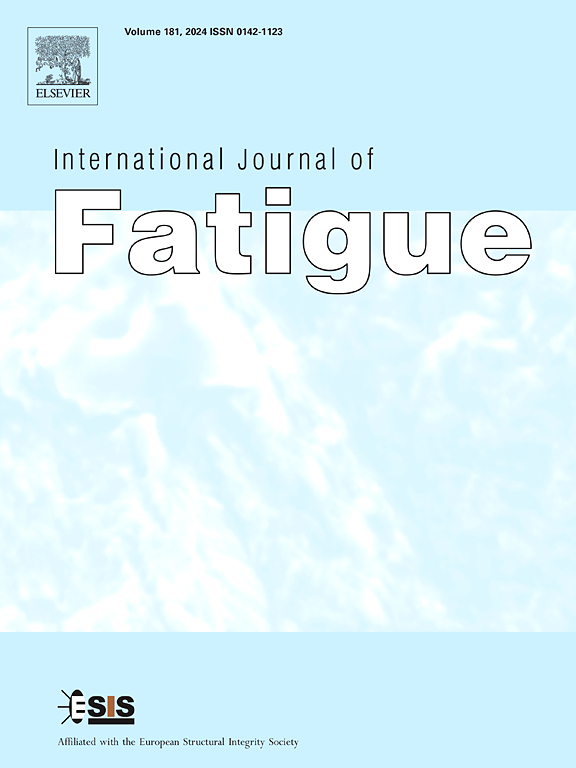Effect of hold time on dwell fatigue behavior of Ti-6.5Al-3.5Mo-1.5Zr-0.3Si alloy with equiaxed microstructure
IF 6.8
2区 材料科学
Q1 ENGINEERING, MECHANICAL
引用次数: 0
Abstract
Dwell fatigue in titanium alloys has remained a persistent challenge to aero-engine safety for over five decades. In this work, in order to provide an adequate assessment of the dwell sensitivity of Ti-6.5Al-3.5Mo-1.5Zr-0.3Si alloy with equiaxed microstructure, the effect of hold time on its dwell fatigue behavior was investigated. As the hold time increased, a saturation of fatigue life was observed. Small crack growth behavior during dwell fatigue failure was thought to be a critical factor responsible for this phenomenon. As the hold time increased, the crystallographic orientations of facets at the small crack growth regions evolved towards a harder orientation and eventually exhibited saturation, which consequently caused the small crack growth rate to level off. Whereas no difference in the orientations of the crack initiation facets was observed, as crack preferentially initiated from an α grain well-oriented for basal slip in the hard macrozone. Furthermore, according to the crystallographic orientations of the growth facets obtained directly from the fracture surfaces, a threshold range was defined to effectively identify effective structural units (ESUs) in alloy.
保温时间对等轴组织Ti-6.5Al-3.5Mo-1.5Zr-0.3Si合金疲劳行为的影响
50多年来,钛合金的停留疲劳一直是航空发动机安全面临的一个持续挑战。为了充分评价Ti-6.5Al-3.5Mo-1.5Zr-0.3Si等轴组织合金的停留灵敏度,研究了保温时间对其停留疲劳行为的影响。随着保温时间的增加,疲劳寿命趋于饱和。居住疲劳失效过程中的小裂纹扩展行为被认为是造成这一现象的关键因素。随着保温时间的增加,小裂纹扩展区域的晶面取向逐渐向硬取向发展,最终趋于饱和,导致小裂纹扩展速率趋于平稳。而裂纹起裂面取向没有差异,在硬宏观区中,裂纹优先从取向良好的α晶粒开始。此外,根据直接从断裂面获得的生长面的晶体取向,定义了有效识别合金中有效结构单元的阈值范围。
本文章由计算机程序翻译,如有差异,请以英文原文为准。
求助全文
约1分钟内获得全文
求助全文
来源期刊

International Journal of Fatigue
工程技术-材料科学:综合
CiteScore
10.70
自引率
21.70%
发文量
619
审稿时长
58 days
期刊介绍:
Typical subjects discussed in International Journal of Fatigue address:
Novel fatigue testing and characterization methods (new kinds of fatigue tests, critical evaluation of existing methods, in situ measurement of fatigue degradation, non-contact field measurements)
Multiaxial fatigue and complex loading effects of materials and structures, exploring state-of-the-art concepts in degradation under cyclic loading
Fatigue in the very high cycle regime, including failure mode transitions from surface to subsurface, effects of surface treatment, processing, and loading conditions
Modeling (including degradation processes and related driving forces, multiscale/multi-resolution methods, computational hierarchical and concurrent methods for coupled component and material responses, novel methods for notch root analysis, fracture mechanics, damage mechanics, crack growth kinetics, life prediction and durability, and prediction of stochastic fatigue behavior reflecting microstructure and service conditions)
Models for early stages of fatigue crack formation and growth that explicitly consider microstructure and relevant materials science aspects
Understanding the influence or manufacturing and processing route on fatigue degradation, and embedding this understanding in more predictive schemes for mitigation and design against fatigue
Prognosis and damage state awareness (including sensors, monitoring, methodology, interactive control, accelerated methods, data interpretation)
Applications of technologies associated with fatigue and their implications for structural integrity and reliability. This includes issues related to design, operation and maintenance, i.e., life cycle engineering
Smart materials and structures that can sense and mitigate fatigue degradation
Fatigue of devices and structures at small scales, including effects of process route and surfaces/interfaces.
 求助内容:
求助内容: 应助结果提醒方式:
应助结果提醒方式:


